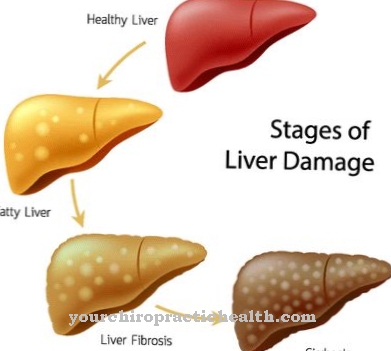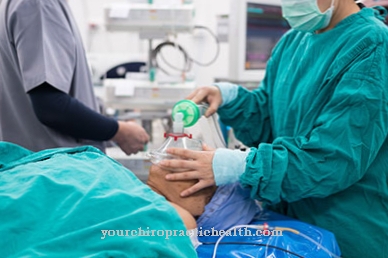To form a so-called Horseshoe kidney it always occurs when the lower poles of the two kidneys fuse together. Already in the womb, the kidneys are shifted somewhat and no longer resemble normal development. However, the development of the ureters occurs normally.
What is a horseshoe kidney?

© blueringmedia - stock.adobe.com
When the two kidneys below grow together during the development of an embryo in the womb, a so-called Horseshoe kidney spoken. At times, only part of the kidneys may not have grown properly. The creation of a horseshoe kidney already takes place during embryonic development during pregnancy.
It is a congenital kidney malformation that is either genetically determined or caused by external influences. Corrective interventions during pregnancy cannot be carried out. With the formation of a horseshoe kidney, there is a great risk that those affected will suffer from urinary tract diseases such as various infections more frequently in their further life. Kidney stones can also occur more frequently.
However, many sufferers do not even know that they live with a horseshoe kidney and have already been born, as it does not necessarily cause symptoms. The kidneys can often take over their function completely normally. For this reason, invasive interventions, treatments and therapies are often not necessary. These measures are usually only required when complaints arise.
causes
The horseshoe kidney generally refers to an abnormality in the human kidney. The reasons for this are genetic defects, i.e. defects on the chromosomal level. Environmental influences may also be responsible for the formation of the horseshoe kidney. The horseshoe kidney is present from birth and is already formed during the embryonic phase in the womb.
Both kidneys have grown together at the lower ends. They thus form the shape of a horseshoe, hence the name horseshoe kidney. This malformation is one of many in the kidney area and, with 15 percent of all kidney malformations, occurs comparatively rarely. Although both kidneys are fused together, they have separate kidney and blood vessels.
The urinary tracts are also separated from one another, as in people with normally developed kidneys. The bladder is also in its normal place. Boys are usually more often affected by the malformation of the horseshoe kidney than girls. Often other organ anomalies occur in this context.
Due to the fusion of the kidney tissue, the kidneys of those affected are usually completely immobile. This increases the risk of kidney damage in trauma and injury to the abdomen. Since it may be difficult to show the horseshoe kidney in an imaging procedure, those affected usually never find out about the presence of such a malformation.
Symptoms, ailments & signs
In many cases, people with a horseshoe kidney will not show any symptoms in the course of their lives. Nevertheless, it can happen that the malformation has an impact on the body and different complaints can express themselves. The main symptoms of horseshoe kidney include pain and uncomfortable pressure in the surrounding organs.
The reason for this is the pressure that the malformed kidneys exert on them. It may also lead to gastrointestinal disorders in the person concerned. In rare cases, compression of the aorta can also occur. In this case, the symptoms manifest themselves as circulatory disorders in the legs and feet, as well as numbness.
Sometimes compression of the inferior vena cava can also occur and varicose veins develop. After many years, various diseases that can be traced back to the horseshoe kidney can also develop. This can be kidney stones or the formation of a so-called water sac kidney. In addition, a connection between the horseshoe kidney and the development of various tumors is suspected, which mainly occur in the neck area.
Diagnosis & course of disease
For the diagnosis of the horseshoe kidney, the radiological examination methods provided in urology are used. These are conventional sonography, i.e. ultrasound examination, urography, computed tomography and magnetic resonance tomography. Most often, the presence of a horseshoe kidney is harmless.
Therapy is not necessary in most cases. However, urinary flow disorders, infections or kidney stones can definitely occur. In these cases, therapy for the horseshoe kidney must be started. It is of great importance that children with this kidney malformation have an increased risk of developing malignant kidney tumors. In concrete terms, this risk is six times higher than that of those who are not affected.
Complications
A horseshoe kidney does not necessarily have to lead to severe discomfort or complications. In many cases, the patient does not experience any symptoms and thus no complications. In this case, no direct treatment of the horseshoe kidney is necessary. However, there may also be uncomfortable feelings of pressure in the patient's abdomen.
The kidneys can also move the surrounding organs or have a generally negative effect on them. The gastrointestinal tract is also often disturbed by the horseshoe kidney and does not function properly. Disturbances in the blood circulation often lead to cramps or numbness. These often lead to severe restrictions on movement.
The risk of tumors is also greatly increased by the disease, so that the patient usually has to be examined more often. The diagnosis of horseshoe kidney is made relatively early and quickly, so that early treatment can be initiated. If there are any symptoms, the horseshoe kidney can be treated surgically or completely removed. There are no further complications. Life expectancy is not limited or reduced by consistent treatment.
When should you go to the doctor?
A horseshoe kidney often does not cause any symptoms and therefore does not require medical treatment. However, if symptoms such as severe pain, an uncomfortable feeling of pressure in the stomach smoke or disturbances in gastrointestinal activity arise, a visit to a doctor is recommended. Medical advice is required in the case of circulatory disorders in the legs and numbness in the limbs. It may be due to compression of the aorta, which, if left untreated, can lead to serious complications.
At the latest when varicose veins or signs of a water sac kidney are noticed, you should speak to your family doctor or a nephrologist. People with cancer should discuss these symptoms with their doctor. A horseshoe kidney usually occurs in connection with a genetic defect. Parents of children diagnosed with such a defect should pay particular attention to any noticeable symptoms. If in doubt, the child must be examined by a specialist. In the event of severe complaints, it is best to call the emergency services or the child should be taken to a specialist clinic.
Doctors & therapists in your area
Treatment & Therapy
As a standard, malformations of the kidneys such as the horseshoe kidney are treated surgically if symptoms arise or other symptoms and physical impairments occur. Surgery is sometimes necessary in children when the kidneys are causing great pain in the fused area due to a constriction.
In this case, the intervention is carried out directly at this point. The kidneys are fixed in a normal position. In rare cases, the horseshoe kidney can also develop kidney dysfunction, which can then have a significant impact on the patient's health. In this case, the affected half or part of the kidney is surgically removed. This is known in technical terms as a heminephrectomy.
Outlook & forecast
If there are no other impairments or disorders, the prognosis of a horseshoe kidney is favorable. Many patients do not experience any health disorders or secondary diseases for their entire life due to the changed tissue structure. The kidneys do a similar job to that of a healthy person. There is also no shortening of the lifetime.
However, some people with a horseshoe kidney have a worse prognosis. Due to the abnormality of the organ, there is an increased risk of developing more infections of the urinary tract in the course of life. Although these can be diagnosed quickly and are easily treatable, there are repeated adverse effects on health and thus well-being.
If left untreated, inflammation in these patients can spread unhindered. Organ damage to the kidneys can also develop. The failure of the kidneys to function becomes more likely. This threatens the need for a donor organ and a potential danger to life.
Medical care is intended to prevent further diseases or permanent damage to the kidneys. In severe cases, a tumor develops. Patients with a horseshoe kidney are generally at an increased risk of developing a kidney tumor. If it is not recognized early and completely removed, the affected person can die prematurely.
prevention
In principle, no preventive measures can be taken against the formation of a horseshoe kidney. Since it is a congenital defect based on genetic causes or embryonic development disorders, it is not possible to counteract the formation of a horseshoe kidney during pregnancy.
Aftercare
In most cases, follow-up measures for a horseshoe kidney are severely limited.The person concerned is dependent on immediate treatment if the disease also leads to other complaints in the other internal organs of the person concerned. Whether the horseshoe kidney will lead to a reduced life expectancy for the patient cannot generally be predicted.
The focus is therefore on the early detection of the disease, with the horseshoe kidney ideally being detected directly in the womb. Treatment for this disease occurs only when the disease affects certain functions in the body. Therefore, concerned parents should have their children examined regularly by a doctor in order to identify all body functions.
The treatment is carried out by a surgical procedure, which usually runs without complications and relieves the discomfort of the horseshoe kidney. After the procedure, the child should definitely rest and not exert themselves. Stressful or physical activities should also be avoided. If the disease is treated early, there are usually no complications or reduced life expectancy. In some cases the risk of ureteral infections from the disease can increase, so these should be avoided.
You can do that yourself
The classic horseshoe kidney often has no disease value, but is rather classified under the anatomical features. Many sufferers have no complaints or only get them late in life. In other cases, the presence of the horseshoe kidney may cause dysfunction. The kidney function can be disturbed to the extent that there can be problems with urine flow and urination, for example.
Anyone who has a horseshoe kidney should have regular check-ups with their doctor. In this way, possible complications can be identified and treated at an early stage. People who are equipped with this anatomical feature can also pay particular attention to the health of their kidneys. A lifestyle that does not overload the kidneys is highly recommended. For example, those affected can refrain from excessive consumption of meat, especially very fatty meat. Stimulants such as alcohol, caffeine and nicotine should also be avoided, as most of these substances are filtered out of the body by the kidneys. Painkillers such as headache medication or anti-inflammatory drugs should also be taken very consciously and only when actually necessary. All of these substances put an above-average strain on the kidneys.
If you want to take care of your health, you should drink a lot. Two to three liters of water, tea or other unsweetened drinks have a positive effect on kidney function.

.jpg)


.jpg)






















